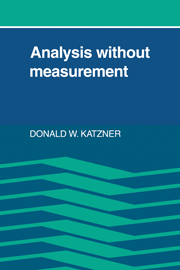Book contents
- Frontmatter
- Contents
- Preface
- Dedication
- 1 Introduction
- 2 Notes on measurement
- Part I Theoretical methods
- 3 Basic concepts
- 4 Algebraic structure
- 5 Analysis of specific systems
- 6 General systems
- 7 Some epistemological considerations
- Part II Applications to theoretical problems
- Part III Empirical verification
- Index
4 - Algebraic structure
Published online by Cambridge University Press: 04 August 2010
- Frontmatter
- Contents
- Preface
- Dedication
- 1 Introduction
- 2 Notes on measurement
- Part I Theoretical methods
- 3 Basic concepts
- 4 Algebraic structure
- 5 Analysis of specific systems
- 6 General systems
- 7 Some epistemological considerations
- Part II Applications to theoretical problems
- Part III Empirical verification
- Index
Summary
Although, as clearly apparent by now, there are a considerable number of set-theoretic and topological concepts and propositions available for use, even in the absence of measurement, it is still not enough. The inclusion of nonquantifiable objects in an analytical framework obviously requires that addition, subtraction, multiplication, division, and so forth be dropped. These must be replaced with other manipulative tools before proceeding. In doing so, one naturally turns to algebraic operations on functions, several of which may be performed regardless of whether their variables can be measured.
This chapter develops an algebraic structure to serve as the basis for subsequent analysis. The general theory of semigroups of partial transformations is outlined first, followed by a discussion of the specific circumstance in which it is employed later on. Once again, because all results are, at worst, relatively minor deviants of well-known propositions, no proofs are given. They may be found in Birkhoff and MacLane and Ljapin. A more general and comprehensive development is provided by Schweizer and Sklar.
Semigroups of partial transformations
It is appropriate to begin with a few preliminaries. Let X and Z be sets. As suggested in Section 2.2, an operation on X is a function g: X × X → Z. Function values under g are often written as, say, x′·x″ instead of g(x′, x″), where x′ and x″ are in X and the “·” replaces g as the operation symbol.
- Type
- Chapter
- Information
- Analysis Without Measurement , pp. 79 - 88Publisher: Cambridge University PressPrint publication year: 1983



